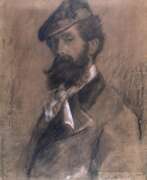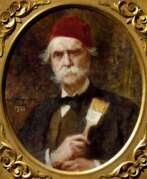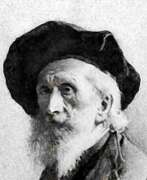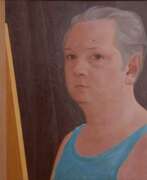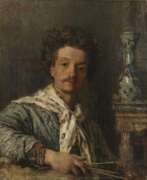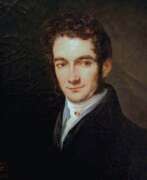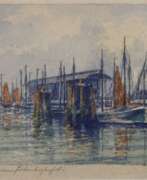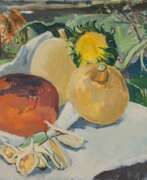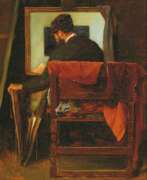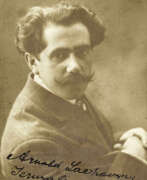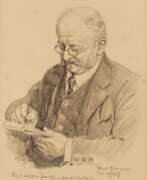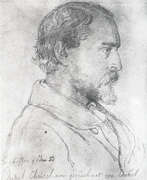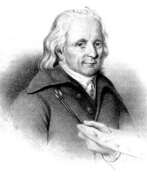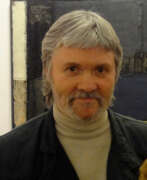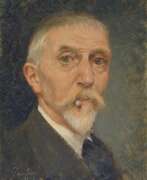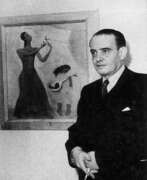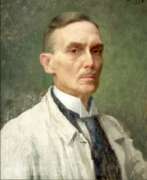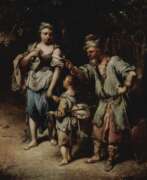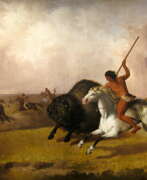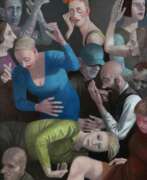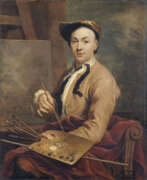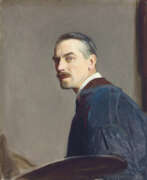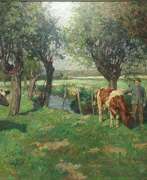Genre painters Self-portrait
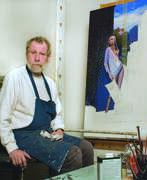

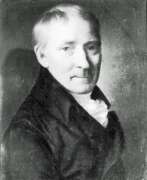

Daniel Caffé was a distinguished German pastel painter of portraits. Known for his meticulous craftsmanship and the emotive depth of his portraiture, Caffé initially embarked on a career in architectural decoration before his talents led him to Dresden to become a portrait artist.
Daniel Caffé's journey into the world of fine arts was marked by his study at the Dresden Academy of Fine Arts under the guidance of significant figures like Casanova and the influence of neoclassical artist Anton Raphael Mengs. His mastery of pastel made him a favored portraitist among the nobility and notable figures of his time, including Russian patrons like Prince Beloselski and Admiral Fyodor Grigoryevich Orloff.
His works, celebrated for their detailed and expressive nature, capture the essence of his subjects with striking realism and emotional depth. Among his notable works are portraits of prominent individuals such as Johann George Tromlitz and Karl August von Hardenberg, which not only exemplify his skill but also his contribution to the documentation of his era's influential figures.
Daniel Caffé's legacy as a pastel painter is preserved in various art collections and continues to be admired for its historical significance and artistic merit. He passed away on January 16, 1815, in Leipzig, leaving behind a body of work that continues to be studied and revered in the art community.
For collectors and experts in art and antiques, Daniel Caffé's portraits offer a glimpse into the refined pastel techniques and cultural narratives of the late 18th to early 19th century. His works remain a significant part of German art history, celebrated for their contribution to the development of portrait painting.
To explore more about Daniel Caffé’s life and works, consider signing up for updates on exhibitions and auctions where his art is featured. This will provide opportunities to engage more deeply with the legacy of this notable artist.
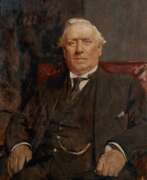

André Edmond Alfred Cluysenaar was a Belgian painter. He was especially known for portraits and female figures. He was member of the Cluysenaar family, descendant from a long line of architects who originated in Aachen. He received his first art lessons from his father, then studied with François-Joseph Navez. Initially, he worked as a sculptor, but devoted himself entirely to painting after 1902. He was firmly grounded in the romantic style at first; producing still lifes and genre scenes, but later turned to impressionism and painted mostly female figures, often semi-nude. He also executed monumental ceiling paintings for the City Hall in Saint-Gilles. During World War I, he lived in London where he established a reputation painting portraits of notable people, including the Royal Family, which were done in a more commercial style using Alfred Stevens as a model. Most of these portraits may be seen in the National Gallery.
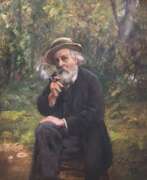

Léon Marie Constant Dansaert was an outstanding Belgian artist and illustrator. His work has left a significant trace in the world art history and art history due to his unique style and skill as a painter.
Léon Marie Constant Dansart was famous for his portraits and genre scenes, which were characterised by a deep psychological understanding of the models. In his works, the desire to convey not only the physical resemblance, but also the inner world of the portrayed personalities is clearly visible.
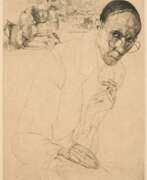

Jules De Bruycker, a Belgian graphic artist and etcher, is renowned for his depictions of Ghent, cathedrals, war scenes, and book illustrations. He achieved technical virtuosity in his prints and was considered one of Belgium's greatest etchers. His work showcased crowds and dramatic lighting, providing an intimate view of daily life in Ghent. De Bruycker's influences ranged from Flemish traditions to artists like Brueghel, Bosch, and Ensor. His later work included prints of cathedrals, figure studies, and sensuous nudes. De Bruycker's art greatly influenced his contemporaries, including Gustave van de Woestijne.
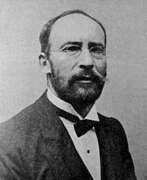

Meijer Isaac de Haan was a Dutch painter. In 1874, he was accepted into the Rijksacademie van beeldende kunsten at Amsterdam. In 1880, one of his works was exhibited at the Paris Salon. That same year, an illustration of de Haan's picture Een moeilijke plaats in de Talmoed appeared in the newspaper Eigen Haard, which generated much published discussion (not so much aesthetic as theological). He enjoyed some success in the Netherlands as a painter of Jewish genre works. In Amsterdam de Haan painted portraits and took on several pupils. De Haan remained in Amsterdam until 1888, where he produced chiefly portraiture, and representations of working class Jews. His early work was inspired above all by the masters of the Dutch school, such as David Teniers and Rembrandt. The example of 17th century painting is reflected in his history painting of 1877–1888.
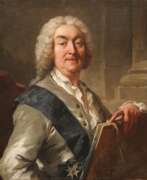

Jean-François de Troy was a French Rococo easel and fresco painter, draughtsman and tapestry designer. One of France's leading history painters in his time, he was equally successful with his decorative paintings, genre scenes and portraits. He was the inventor of the tableaux de modes ('paintings of fashions'), which attempted to provide a spirited portrayal of contemporary fashions, pastimes and manners.
He was the Director of the French Academy in Rome from 1738.
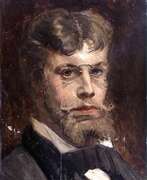

Jean-Joseph Delvin was a Belgian painter who specialized in scenes with animals (primarily horses). He attended the Royal Academy of Fine Arts in Ghent, where he studied under Théodore-Joseph Canneel, and worked in the studios of Jean Portaels in Brussels. Later, he undertook study trips to France and Spain. For many years, he shared a small workshop in a garden shed with Gustave Den Duyts. In 1883, he was invited to join the secessionist group Les XX, but he resigned only a few years later in 1886. He was also a member of La Libre Esthétique and Kunst van Heden (Art for Today) in Antwerp. At about that time, he began teaching at the Academy in Ghent and later became its Director (1902–1913). Among his many well-known students there were Albert Baertsoen, Gustave De Smet, Frans Masereel, George Minne and Frits Van den Berghe.


Otto Eerelman was a Dutch painter; best known for his depictions of dogs and horses. He was also a court painter and did several portraits of Wilhelmina, as Princess and Queen. His best known painting, "De paardenkeuring op de Grote Markt op de 28ste augustus", depicts an annual celebration (featuring horses) held to commemorate the lifting of the Siege of Groningen.
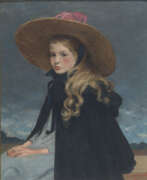

Henri-Jacques-Edouard Evenepoel was a Belgian artist whose most important works are associated with Fauvism. The artist debuted a portrait of his cousin (Louise in Mourning) at the 1894 Salon des Artistes Français. He showed four portraits at the Salon du Champ-de-Mars in 1895 and continued to exhibit there until his death. His first solo exhibition came at the Brussels Cercle Artistique (December 1897 – January 1898). Family and friends were the artist's preferred subjects; his full-length portraits, often against a neutral background, show the influence of Édouard Manet and James Abbott McNeill Whistler. His Parisian scenes were influenced by Henri de Toulouse-Lautrec and Jean-Louis Forain. Though his early scenes had a somber palette, his paintings while in Algeria (where he first wintered during his solo exhibition) were very different in style, anticipating the bold colours of Fauvism (e.g., Orange Market, Blidah).
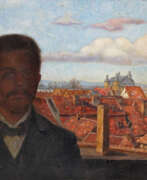

Carl Friedrich Wilhelm Geist was a German Impressionist painter. In 1888, he entered the Academy of Fine Arts, Karlsruhe. With a scholarship from the Grand Ducal Ministry of the Interior, he undertook further studies in Munich, Vienna and Italy. In 1900, he exhibited at the Glaspalast. Although he was officially enrolled at Karlsruhe until 1905, he actually pursued his studies in Stuttgart. He briefly lived in Darmstadt, then returned to Grünberg in 1905 although, as a free-lance painter, he travelled frequently to visit his clients. After 1915 he lived in Wimpfen. World War I hit him very hard; especially the loss of friends such as August Macke and Franz Marc. In response, he abandoned impressionism for a gloomier Academic style.
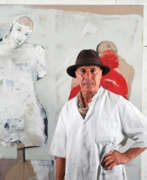

Bahram Hajou is a Kurdish painter whose works can be classified as Neo-Expressionism. He lives and works in Münster as a freelance artist. In 1974 Bahram emigrated to Germany, where he studied at the Münster Art Academy from 1978 to 1984. Since 1981 he has taken part in exhibitions at home and abroad.
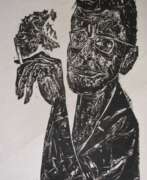

Karl-Heinz Hansen-Bahia, born in 1915 in Hamburg, Germany, was a multi-faceted artist whose work spanned various mediums, including woodblock prints, painting, sculpture, and filmmaking. His artistic journey began in earnest after World War II, with his first woodcut created in 1946. His early work, heavily influenced by the renowned artist Dürer, focused on religious scenes, showcasing his intricate and expressive style.
In 1949, Hansen-Bahia emigrated to Brazil, a move that profoundly influenced his artistic style and career. He taught art in São Paulo and later moved to Salvador Bahia, where his first exhibitions in the country were held. His work during this period began to reflect more of his adopted country's influence than his German origins, leading to a distinctive style that contributed to his prominence as a post-war German artist.
Hansen-Bahia's connection to Germany remained strong despite his move to Brazil. He returned briefly to Germany but later accepted a professorship at the Art Academy in Addis Ababa, Ethiopia. After gaining Brazilian citizenship, he continued to exhibit his work internationally, including in Europe, Japan, and the Americas. His importance in the Brazilian art scene was significant, as he became known for his portrayals of the people and landscape of the state of Bahia.
His artistic legacy was celebrated in extensive retrospectives held in Germany in 1971-72, which were among the last before his death in Brazil in 1976. Hansen-Bahia's work is a testament to his versatility and ability to adapt and evolve his style in response to his changing environments and experiences.
To stay informed about Karl-Heinz Hansen-Bahia, collectors, auctioneers, and art experts are encouraged to sign up for updates. These updates will provide information about new product sales and auction events related to Hansen-Bahia's art.


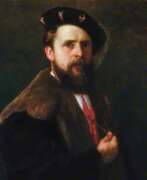

Robert Jobling was a British artist. He first had work accepted by both the Royal Academy and Royal Society of British Artists in 1883. He painted regularly at the fishing village of Cullercoats and later at Staithes. He attained a position of some standing in the Staithes group. His main artistic exposure was in exhibitions in the north of England.
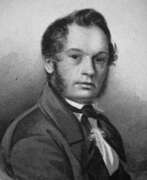

Evgraf Fedorovich Krendovsky (Russian: Евграф Фёдорович Крендовский) was a Russian artist born in 1810 in Kremenchuk, now part of Ukraine, renowned for his work in portrait, genre, and interior painting. Initially engaged in police work in Arzamas, Krendovsky shifted his focus to art, studying under the guidance of Alexey Venetsianov in St. Petersburg from 1830 to 1835. Despite a promising start, family circumstances forced him to return to Kremenchuk, where he became a drawing tutor and later achieved the status of "Free Artist" by the Imperial Academy of Arts.
Krendovsky's career is marked by a relatively small body of work, with just over twenty known paintings to his name. Some of his most celebrated pieces include portraits and scenes depicting the daily life of Russian society, which now grace collections such as the Tretyakov Gallery in Moscow and the Russian Museum in St. Petersburg. His notable works include "Portrait of an Unknown Woman in a Violet Dress" and "The Artist’s Daughters" from 1845.
For art enthusiasts and collectors interested in 19th-century Russian art, Krendovsky remains a figure of fascination due to his unique style and the historical context of his works. To stay updated on upcoming sales and auction events featuring Krendovsky's works, sign up for updates at [Link to subscription page]. This subscription will keep you informed about new opportunities to acquire pieces by this distinctive artist.
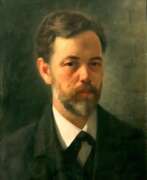

Andronik Grigorievich Lazarchuk (Russian: Андроник Григорьевич Лазарчук) was a Ukrainian and Soviet artist, born on January 15, 1870, in Ukhovetsk, Volhynian Governorate, and passed away on September 6, 1934, in Borzna, Chernihiv region. Known for his contributions to painting, teaching, and cultural activities, Lazarchuk's work primarily featured portraits, everyday scenes, and landscapes.
Lazarchuk began his artistic journey studying icon painting in Kovel and later in the Pochaev Lavra's painting workshop. From 1889 to 1897, he attended the Higher Art School at the Imperial Academy of Arts in St. Petersburg, where he studied under prominent artist Vladimir Makovsky. His artistic style was influenced by his early religious training, which is evident in his detailed and expressive portraits and landscapes.
One of his notable works, "Portrait of a Man," showcases his ability to capture human emotion and character. His other works include small-format paintings like "Reading a Letter" and "Family Group," which highlight his focus on everyday life and personal interactions. Lazarchuk also contributed to the decoration of Ukrainian churches, such as the Holy Trinity Church and the Cave Churches of Pochaev Lavra, and worked as an illustrator for magazines like "Native Land" and "Young Ukraine".
Collectors and art enthusiasts can explore Lazarchuk's legacy by signing up for updates on new product sales and auction events related to his works. This subscription will keep you informed about opportunities to acquire pieces by this influential artist.


Adolf Luntz was a German painter, etcher, and lithographer, was known for his landscapes and figurative works. Inspired by his architect father, Viktor Luntz, Adolf joined the Vienna Academy of Fine Arts in 1892. After studying in Vienna until 1897, he became a master student of Gustav Schönleber at the Karlsruhe Academy of Fine Arts. Luntz accompanied Schönleber on various study trips and designed collectible images for the Stollwerck company in Cologne. He settled in Karlsruhe in 1905 and was a member of the German Artists' Association.
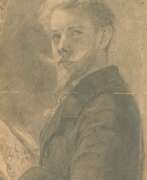

Henry Luyten was a Belgian painter of Dutch origin. He is known for his genre scenes, landscapes and portraits.
Henry Luyten was influenced by the 19th century Hague School and the Barbizon School, as well as 17th century Dutch and Flemish painting.
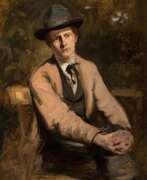

William Darling McKay is a Scottish artist, known for his landscapes. He came to Edinburgh at the age of 16 and was first noticed ten years later for a series of pastorals, in which figures played an important part. He was awarded an honorary LLD by the University of Edinburgh in 1919 and thereafter known as Dr McKay. In 1872, when on a painting excursion to Cadzow Forest, he became increasingly interested in watercolour painting. Best remembered as the author of The Scottish School of Painting (1906) which, although a pioneer work, encompassed the 18th century in a mere eight pages.
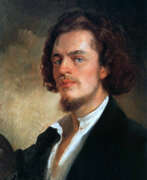

Konstantin Yegorovich Makovsky (Russian: Константин Егорович Маковский) was a renowned Russian painter, celebrated for his romantic and historical paintings that often portrayed an idealized view of Russian life in previous centuries. Born in Moscow in 1839, Makovsky became a pivotal figure in Russian art, distinguishing himself early on at the Moscow School of Painting, Sculpture and Architecture and later at the Imperial Academy of Arts in Saint Petersburg.
Makovsky was a core member of the "Peredvizhniki" or Wanderers, a group advocating for realism and social critique through art. His commitment to depicting the everyday life of old Russia won him accolades, including the Large Gold Medal at the World's Fair in Paris in 1889. Some of his notable works include "The Russian Bride's Attire" and "The Boyar Wedding Feast," which reflect his mastery in capturing the lavish and picturesque aspects of Russian history and culture.
Tragically, Makovsky's life ended in a road accident in Saint Petersburg in 1915, but his legacy lives on through his profound impact on Russian art and culture. His works continue to be highly regarded and are featured in major museums and collections worldwide.
For those interested in exploring Konstantin Makovsky's work further or acquiring pieces related to his artistic legacy, stay updated with our newsletters for announcements on sales and auction events. Sign up to not miss out on the opportunity to own a piece of Russian art history.


Matthias Maris was a Dutch painter, etcher and lithographer. He initially belonged to the Hague School, like his two brothers, Jacob and Willem, but his later works deviated more and more from that school into a unique style influenced by the Pre-Raphaelites. Most of the paintings by M. Maris are in museums and private collections in Great Britain and the USA. A great admirer of the artist's talent was Vincent van Gogh.


Oskar Martin-Amorbach was a German painter. After completing his studies and getting married, Martin-Amorbach moved to Samerberg in Chiemgau, where he became the youngest member of the artists' association "Die Welle". He became more public through his fresco in the Munich Glass Palace. In 1937 he joined the NSDAP. On July 16, 1939 he was awarded the title of professor in Munich. In 1943 he was appointed professor of history painting at the Berlin Academy of Fine Arts. The style of painting and the selection of motifs in Martin-Amorbach's works were predestined to be appropriated by National Socialist art policy. Rural and rural motifs and depictions of war were themes that were of particular importance for Nazi ideology. The peasant genre, presented in the style of the new objectivity in the wake of Wilhelm Leibl and Franz von Defregger, was intended to depict the peasantry as the "source of blood and life" and the backbone of the "German people's power" and the " national attitude". The images The Sower and The Harvest met these ideological guidelines perfectly. Martin-Amorbach also contributed to the war themes with, among other things, the picture You Drive Death. His popularity in the Third Reich put a strain on his further artistic work after 1945. In 1950 Bishop Julius Döpfner commissioned him to revise and supplement the frescoes in the Neumünster Church in Würzburg, which had been severely damaged by the bombing raid on Würzburg. Martin-Amorbach carried out this work in 1950/51.
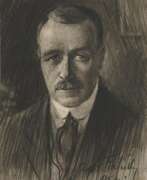

Benjamin Edwin Minns was an Australian artist, recognised as one of Australia's foremost watercolourists. Minns obtained his first job at the Illustrated Sydney News; Minns also drew for the Sydney Mail and regularly contributed to The Bulletin. From 1895 to 1915 Minns worked in England, contributing to St Paul's Magazine, Punch, The Strand Magazine, the Bystander and other publications as well as sending drawings to The Bulletin. Minns was a founder in 1924 and inaugural president (until 1937) of the Australian Watercolour Institute.
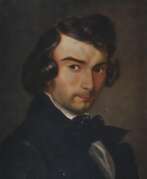

Apollon Nikolaevich Mokritsky (Russian: Аполлон Николаевич Мокрицкий) was a Ukrainian-Russian painter and art educator, known for his contributions to the 19th-century art scene. Born in 1810 in Pyryatyn, Ukraine, Mokritsky became an influential figure in Russian academic art, specializing in portrait and historical painting.
Mokritsky's work is celebrated for its detailed realism and emotional depth. His portraits often capture the essence of his subjects, showcasing his skill in rendering lifelike expressions and intricate details. One of his most notable works is the portrait of the renowned Russian poet, Taras Shevchenko, which exemplifies his ability to combine technical precision with profound sensitivity.
In addition to his painting, Mokritsky played a significant role as an educator. He taught at the Moscow School of Painting, Sculpture and Architecture, where he mentored many young artists who would go on to shape Russian art. His influence extended beyond his own works, helping to cultivate a new generation of artists.
Today, Mokritsky's paintings can be found in various museums and galleries, including the Tretyakov Gallery in Moscow. His contributions to art and education continue to be recognized and celebrated by art collectors and historians alike.
Sign up for updates to learn more about new product sales and auction events related to Apollon Nikolaevich Mokritsky.


Anton Eduard Müller was an Austrian artist known for his contributions to painting, art, culture and history. Born and died in Vienna, he represents the rich artistic tradition of Austria in the second half of the 19th century. Anton Müller received a small gold medal at the annual exhibition in Berlin in 1886.
His works, which may be exhibited in museums and galleries today, reflect the cultural dynamics of his time and offer insights into the aesthetic preferences and social realities of the late 19th century.
As a painter, Müller may have explored a variety of subjects, from portraits to still lifes, showing the versatility and depth of his artistic skills. Today, his artworks may appeal to collectors and art experts interested in Austrian art history.
For all art lovers and collectors interested in Anton Eduard Müller and his works, we recommend registering for updates. Stay informed about new sales and auction events related to Anton Eduard Müller. Don't miss the opportunity to become part of the fascinating world of art and antiques.


Hanna Nagel, a German illustrator, painter, and draughtswoman, was recognized for her critical examination of gender roles and societal norms, particularly focusing on the experiences and representation of women. Hanna Nagel's early works were marked by a patriarchal critique, delving into issues of discrimination and societal conditions faced by women. She studied at the Badische Landeskunstschule Karlsruhe and later at the Vereinigte Staatsschulen für Freie und Angewandte Kunst in Berlin under the guidance of Emil Orlik.
Hanna Nagel's art often featured the female figure, exploring themes of dependency, power dynamics, and the complex roles of women in society. Her style evolved from sharp caricature to a more nuanced and dreamlike representation, with works like "Woman in Blue Dress" exhibited at The Metropolitan Museum of Art reflecting this transition. Throughout her career, she also contributed significantly to book illustration, adding depth to literary works with her expressive visuals.
Hanna Nagel's legacy is preserved through her contributions to German art and culture, with her works displayed in exhibitions and held in collections worldwide. She remains a pivotal figure in the exploration of feminist themes in art, offering a unique perspective on the interplay between gender, identity, and societal expectations.
For those interested in exploring the depth and range of Hanna Nagel's work, consider signing up for updates on exhibitions, sales, and auctions related to her artwork. This subscription will provide insights into available pieces and events celebrating her contributions to art and culture.
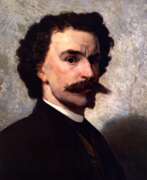

Victor Nehlig was a French-American painter. Born in Paris in 1830, Nehlig studied painting under Léon Cogniet and Abel de Pujol. In 1850, he moved to the United States, where he would live and work for the next 22 years, interrupted only by a brief stay in Havana, Cuba. During his time in the United States, Nehlig opened a studio in New York City and painted a variety of works in the academic style, often demonstrating his prowess at depicting the human figure. Nehlig returned to his native France in 1872, two years after being elected an academician in the National Academy of Design and shortly after his studio and many of his reference materials were destroyed in a devastating fire. While Nehlig was relatively well known among art enthusiasts during his time, his work has seen less attention in subsequent years.[3] He frequently painted interpretations of American history, taking a special interest in scenes from the American Civil War, the effects of which he witnessed firsthand.
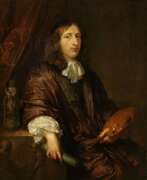

Caspar Netscher was a Dutch painter of the Golden Age of Dutch painting, known for his portraits. Netscher chose subjects from the life of the Dutch elegant and wealthy class; he painted many small portraits - mostly of women; some of them historical. After spending some time in Paris, he painted several persons belonging to the court of Louis XIV. In addition to the above-mentioned usual subjects, he depicted sometimes historical and biblical scenes.
Caspar Netscher's paintings were kept in many art galleries: in the Louvre, Amsterdam, Florence, in several private collections in England and in many other places. In the Hermitage at the beginning of the 20th century there were six of his paintings, including a portrait of the artist himself and a portrait of Mary Stuart, painted in 1683; today only two works have survived.
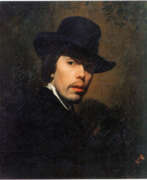

Nikolai Vasilyevich Nevrev (Russian: Никола́й Васи́льевич Не́врев) was a prominent Russian painter, renowned for his genre and historical scenes. Born in 1830 in Moscow into a merchant family, Nevrev's artistic journey began under the tutelage of Mikhail Scotti at the Moscow School of Painting, Sculpture and Architecture from 1851 to 1855. His artistry flourished as he depicted societal critiques and historical narratives with a distinct moral undertone, making significant contributions to Russian visual culture.
Nevrev's paintings, such as "The Bargain" (1866), which illustrates the sale of a serf, and "Oprichniki" (1870s), showcase his mastery in portraying intense dramatic scenes that also reflect social commentaries of the time. His works are celebrated for their deep emotional impact and historical accuracy. Not only did he paint, but he also contributed as a teacher at his alma mater between 1887 and 1890, influencing a new generation of artists.
For those interested in the legacy of Nevrev, his works are displayed in prestigious collections, including the Tretyakov Gallery in Moscow. His life’s work offers an invaluable glimpse into the Russian society of his time and continues to inspire art lovers and collectors worldwide.
For updates on exhibitions and sales related to Nikolai Vasilyevich Nevrev, sign up here. Stay connected to explore the profound narratives captured by this exceptional artist.
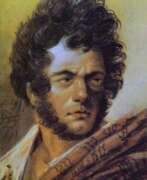

Aleksander Orłowski (Russian: Александр Осипович Орловский), a renowned Polish painter and sketch artist, was born on March 9, 1777, in Warsaw, within the Polish-Lithuanian Commonwealth. His journey into the arts began under challenging circumstances; he was the son of a tavern-keeper and his family was not wealthy. His early promise in art was nurtured by noble patron Izabela Czartoryska, who financed his initial education under the guidance of artist Jan Piotr Norblin.
Orłowski's artistic journey intersected with his military service during the Kościuszko Uprising, a major revolt against Imperial Russia and Prussia in 1794. This period of conflict significantly influenced his later works, which often depicted military scenes and the daily life of soldiers. After the partitions of Poland, Orłowski moved to Saint Petersburg in 1802, where he became a seminal figure in the development of lithography in the Russian Empire.
His oeuvre includes a wide array of subjects, from battle scenes to cultural depictions of everyday life in both Poland and Russia. Notable works such as "Battle Scene" and "Cossack Fighting Off A Tiger" showcase his skill in capturing dynamic movement and drama. His works are preserved in esteemed institutions such as The Russian Museum and The Tretyakov Gallery, highlighting their historical and artistic value.
Orłowski's impact extended beyond the canvas; he was also mentioned in literary works by notable authors like Adam Mickiewicz and Alexander Pushkin, which underscores his cultural significance in the 19th century.
For collectors and experts in art and antiques, Aleksander Orłowski's works represent a crucial segment of Eastern European art history. To stay informed about new discoveries or auction events related to his works, consider subscribing for updates. This subscription ensures you receive timely information tailored to your interests, directly relating to new sales and significant events around Orłowski's art.
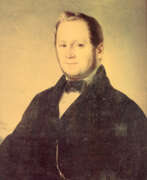

Eugène Pluchart (Russian: Евгений Александрович Плюшар) was a Russian painter and photographer of French descent, born in 1809 in Saint Petersburg and passed away around 1880 in Dresden. Initially trained at the Beaux-Arts de Paris under Louis Hersent, he further honed his skills at the Academy of Fine Arts in Munich. Pluchart's artistry blossomed during a study trip to Italy, which significantly influenced his style.
Pluchart is renowned for his portrait work and frescoes, notably contributing to the décor at Saint Isaac's Cathedral during the 1840s. His mastery in capturing the essence of his subjects is evident in his portraits of notable figures such as the composer Karol Lipiński, which earned him the title of full Academician by the Imperial Academy of Arts. His works also include a notable portrait of the composer that further solidified his reputation.
After a prolific period in Russia, Pluchart moved to Dresden in the early 1860s. His later years were quieter, with his contributions to the arts remaining influential, particularly in Russia and Germany. His works are part of the collection in prominent institutions like the Hermitage Museum and the Alte Nationalgalerie.
For those interested in the works and life of Eugène Pluchart and future auction events related to his art, consider subscribing to updates [insert link here]. This subscription will keep you informed about new product sales and auction events specifically related to Eugène Pluchart, ensuring you stay connected to the latest offerings in his artistic legacy.
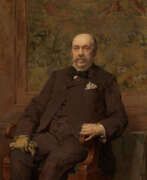

Jean-François Portaels was a distinguished Belgian painter. He is celebrated for his mastery in Orientalist art, genre scenes, and portraits. His education under the tutelage of François-Joseph Navez at the Academy of Brussels shaped his early artistic direction.
Portaels' career was marked by significant academic roles, including his tenure as the director of the Academy of Fine Arts in Ghent and later the Académie Royale des Beaux-Arts in Brussels. His influence extended beyond Belgium through his extensive travels across Europe and North Africa, where he absorbed and later depicted the exotic and vibrant cultures of Morocco, Algeria, Egypt, and Lebanon.
His works, such as "The Oriental Beauty" and "Portrait of Aouicha," are celebrated for their detailed depiction of Eastern subjects, characterized by elaborate costumes and serene expressions. These paintings not only display his technical skill but also his ability to convey the subtle nuances of different cultures.
Portaels was also a key figure in monumental art in Belgium, contributing to national identity through his historical and biblical scenes painted for many Belgian churches. His legacy is preserved in his contributions to the Belgian Orientalist school and his role in shaping the next generation of Belgian artists.
For collectors and experts in art and antiques, Jean-François Portaels' works offer a unique glimpse into the 19th-century Orientalist movement. To stay informed about exhibitions and sales featuring Portaels' art, sign up for our updates and ensure you don't miss out on acquiring a piece of this influential artist's legacy.
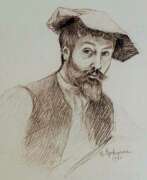

Georges Antoine Rochegrosse was a French historical and decorative painter. His themes are generally historical, and he treated them on a colossal scale and in an emotional naturalistic style, with a distinct revelling in horrible subjects and details. He made his Paris Salon début in 1882 with Vitellis traîné dans les rues de Rome par la populace. He was elected an Officer of the Legion of Honour in 1892 and received the Medal of Honour in 1906 for The Red Delight. Rochegrosse also illustrated several books. Some of the drawings for these illustrations are in the Department of Prints and Drawings at the British Museum, London.


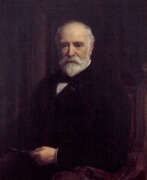

Hendrik Jacobus Scholten was a 19th-century painter from the Netherlands. He was a pupil of Petrus Franciscus Greive and Lambertus Johannes Hansen. In 1852 he became a member of the Royal Academy of Art in Amsterdam, and was a member of the Amsterdam art societies Arti et Amicitiae, Kunstbevorderend Genootschap V.W., and Vereeniging Sint Lucas. He was also a member of art societies in other towns. He became art curator of the Teylers Stichting in 1872, which manages the art collection of the Teylers Museum. In that capacity he wrote a catalog of the museum's collection, that was published in 1904. He painted several paintings that hang in the museum's galleries, as well as decorations in the Teyler's fundatiehuis, where he lived and worked from 1863 until his death.
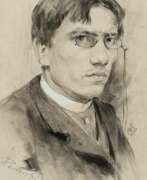

Paul Alfred Schroeter or Schröter was a German painter and etcher. He became a member of the Munich Secession and participated in their first exhibition of 1894. From 1898 to 1901, he lived in Hamburg where he became a co-founder of the Hamburgischer Künstlerklub. Many of his works are in private collections. Most of the others were destroyed during World War II.
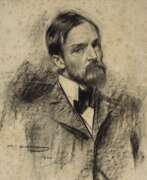

Lucien Simon was a French painter known for his realistic portraits, landscapes and genre scenes of fishermen and peasants. He studied at the Ecole Nationale Supérieure des Beaux-Arts in Paris and has exhibited in Paris and other cities in France.
Lucien Simon often portrayed the life of ordinary people, trying to convey their naturalness and simplicity. In 1934, he was awarded the Legion of Honour for services to art.
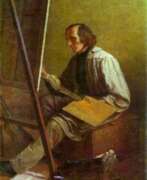

Fyodor Mikhailovich Slavyansky (Russian: Фёдор Михайлович Славянский) was a distinguished Russian painter, known for his remarkable journey from serfdom to academician. Born around 1817 in Vyshkovo, Tver Guberniya, he initially lived as a serf under landlady Avdotya Nikolayevna Semenova. His artistic talent was nurtured by Alexei Venetsianov, who not only mentored him but also purchased his freedom.
Slavyansky's education at the Imperial Academy of Arts began in 1840, where he excelled in drawing under the tutelage of professors Varnek and Markov. By 1845, he was recognized as a freelance artist, and later his portraits, especially of notable personalities, gained him considerable acclaim. His works include "Portrait of V.K. Shebuev" and "Peasant's Girl," both of which demonstrate his skill in capturing the essence of his subjects.
Today, Slavyansky's works are preserved in several prestigious collections, including The Russian Museum in St. Petersburg. His life and art continue to inspire, illustrating a profound narrative of artistic dedication and transformation within 19th-century Russian society .
For updates on exhibitions and sales related to Fyodor Mikhailovich Slavyansky, sign up here. Stay informed about the legacy of this eminent artist and opportunities to appreciate his works firsthand.
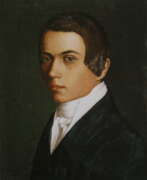

Grigory Vasilyevich Soroka, née Vasiliev (Russian: Григорий Васильевич Сорока) was a Russian painter, known for his mastery in realistic portraits and landscapes that beautifully captured the essence of 19th-century Russia. His artistic journey began under the guidance of his teacher, Alexei Venetsianov, a prominent figure in the Russian art scene. Soroka’s works are remarkable for their attention to detail, vivid portrayal of peasant life, and sensitive handling of light and shadow, distinguishing him from his contemporaries.
His most notable works include "The Peasant Girls Gathering Brushwood" and "Self-Portrait," both exemplifying his skill in using light to express depth and emotion. These paintings are celebrated for their historical and cultural significance, providing a window into the rural life of Russia during that period. Despite his untimely and tragic end, Soroka’s contributions to Russian art have not been forgotten, with several of his works displayed in prestigious galleries, including the Russian Museum in St. Petersburg.
For art collectors and experts, Soroka’s pieces represent a valuable connection to Russian heritage and the realism movement. If you wish to stay informed about upcoming sales and auction events featuring works by Grigory Vasilyevich Soroka, consider signing up for updates. This subscription will ensure you are promptly alerted to new opportunities to acquire pieces by this distinguished artist.
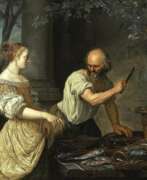

Jacob Toorenvliet was a Dutch painter and graphic artist of the Gilded Age, a master of genre painting and printmaking.
Jacob Toorenvliet was a member of the Leiden Guild of Saint Luke. Together with Willem van Mieris and Carel de Moor he founded the Academy of Arts (Tekenacademie).
Jacob Torenvliet's style of painting has its origins in the genre painting of Leiden. Torenvliet's paintings contain elements of fine painting. The artist incorporates all kinds of influences in his work, but mixes them with his own forms of expression.
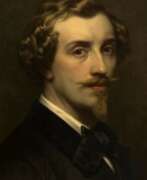

Joseph Henri François Van Lerius was a Belgian painter in the Romantic-Historical style. Van Lerius painted mythological and biblical scenes as well as portraits and genre pictures. Much of his work is didactic in nature. Perhaps his best-known work is "Lady Godiva", which was shown at the Antwerp Triennial Salon in 1870. Many of his works (especially "Lady Godiva" and "Cinderella") have been widely reproduced.
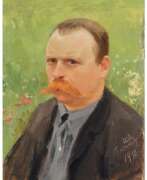

Ivan Alexeyevich Vladimirov (Russian: Иван Алексеевич Владимиров) was a Russian painter and graphic artist, known for his vivid and often stark depictions of the Russian Revolution and its aftermath. Born on January 10, 1870, in Vilnius, Vladimirov became a prominent war artist, documenting the turbulent events of early 20th-century Russia through his art.
Vladimirov's artistic journey began with formal studies at the Vilna Drawing School and later at the St. Petersburg Academy of Arts. His early works focused on battle scenes and everyday life, showcasing his realistic style and attention to detail. During the Russo-Japanese War and World War I, he served as an artist-correspondent, capturing the brutal realities of war.
His most notable works were created during and after the Russian Revolution. Paintings like "On the Streets of Petrograd" and "Hungry Times in Petrograd" portray the harsh conditions and social upheaval of the era. Vladimirov's art provides a critical lens on the revolution, illustrating both the triumphs and tragedies of the period. His works are housed in various collections, including the Williamson Art Gallery & Museum.
To stay updated on new exhibitions and auction events related to Ivan Alexeyevich Vladimirov, sign up for our newsletter. You'll receive timely alerts on new product sales and special events related to this influential artist.


Johann Karl Ferdinand von Kügelgen was a German landscape and history painter, known for his work as a Russian court painter and his contributions to both the Imperial Academy of Arts in St. Petersburg and the Prussian Academy of Arts in Berlin. Born on February 6, 1772, in Bacharach am Rhein, Kügelgen's artistic journey took him across Europe, where he honed his skills in various cities including Frankfurt, Würzburg, and Rome.
Kügelgen's paintings are celebrated for their transparency and ethereal color palette, often reflecting the natural landscapes he was deeply inspired by. His notable works include over 200 landscapes and depictions of ancient monuments, particularly from his travels to Crimea under the commission of Tsar Alexander I. These works are highly valued for their historical and artistic significance, capturing the essence of the regions he explored.
During his career, Kügelgen faced many challenges, including financial difficulties and the turmoil of the Napoleonic Wars, which forced him and his family to flee to Wolsk. Despite these hardships, he continued to produce art and teach, leaving a lasting legacy through his works and his influence on future generations, including his son Konstantin von Kügelgen, who also became a renowned landscape painter.
If you are an art collector or enthusiast, sign up for updates on upcoming sales and auction events related to Johann Karl Ferdinand von Kügelgen. Stay informed about new opportunities to acquire pieces of his remarkable legacy.
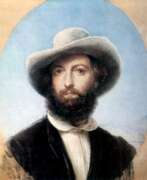

Otto Friedrich Theodor Möller (Russian: Фёдор Антонович Моллер), a Russian academic painter of Baltic-German descent, was renowned for his detailed and expressive portraits, figure paintings, and genre scenes. Born in 1812 in Kronstadt, Saint Petersburg, Möller was deeply influenced by his mentor, Karl Briullov, at the Imperial Academy of Fine Arts. His journey as an artist was marked by a successful tenure in Italy, where he embraced the vibrant local culture and further honed his skills, particularly in portraying everyday Italian life and historical narratives .
Möller's artworks are celebrated for their clarity of composition and expressive color palette, traits he mastered under Briullov's guidance. His notable works, like the portrait of Nikolai Gogol, are admired for their lifelike representation and emotional depth. These paintings not only showcase his technical skill but also his ability to capture the subtle nuances of his subjects' personalities.
Möller's contributions to Russian art extend beyond his paintings. He was a professor and a significant figure at the Imperial Society for the Encouragement of the Arts, dedicating much of his later years to teaching and supporting fellow artists. His works are held in high esteem and continue to be featured in major Russian museums, including the Tretyakov Gallery and the Russian Museum.
For collectors and enthusiasts wishing to stay updated on exhibitions and auction events featuring Otto Friedrich Theodor Möller's works, signing up for newsletters and alerts from relevant art institutions can be highly beneficial. This ensures that you remain informed about opportunities to view or purchase his esteemed works.
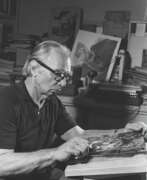

Lynd Kendall Ward was an American artist and novelist, known for his series of wordless novels using wood engraving, and his illustrations for juvenile and adult books. His wordless novels have influenced the development of the graphic novel. Although strongly associated with his wood engravings, he also worked in watercolor, oil, brush and ink, lithography and mezzotint. His best-known books are Gods' Man and his Caldecott-winning children's story, The Biggest Bear.
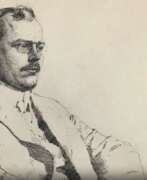

Erich Wolfsfeld was a German painter and etcher known for his classical painting and etching style, especially in portraiture. Born in Krojanke, Western Prussia, in 1884, Wolfsfeld moved to Berlin as a child and later studied at the Berlin Academy of Arts and the Académie Julian in Paris. He began his career with commissions from the Prussian government to make etched copies of Byzantine frescoes, though these were later lost.
Erich Wolfsfeld won the Kaiser Wilhelm Gold Medal in 1911 for his work "The Archers," and by 1914, he was exhibiting in Berlin, Leipzig, and Vienna. His success was notable, with articles about his work published in art journals such as Die Kunst and Kunst fur Alle. He also served in the German army during World War I, where he made studies of wounded soldiers.
In 1920, Erich Wolfsfeld became a professor at the Berlin Academy of Arts, where he taught painting and etching. The rise of Nazism led to his dismissal from the Academy, prompting him to move to Britain in 1939. Despite his move, Wolfsfeld continued to exhibit in the Royal Academy of Arts and had a solo exhibition at the Derby Museum and Art Gallery. His work is represented in various prominent collections, including the British Museum, the Victoria & Albert Museum, and the Metropolitan Museum of Art.
For collectors and art experts, Erich Wolfsfeld's works are highly valued. To stay updated on related product sales and auction events, consider signing up for updates from reputable art galleries and auction houses.
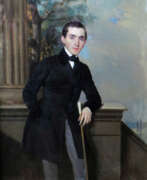

Pyotr Zakharovich Zakharov-Chechenets (Russian: Пётр Захарович Захаров-Чеченец), a Russian painter of Chechen origin, was a notable artistic figure in the 19th century. Born in 1816, he was adopted by Major-General Pyotr Yermolov and showed early talent in painting, which led him to the Imperial Academy of Arts in Saint Petersburg. Despite facing significant obstacles, including racial discrimination that barred him from receiving a scholarship to study in Italy, Zakharov excelled at the Academy and graduated in 1835 with a diploma of Free Artist.
Zakharov became a prominent portraitist, attracting the patronage of significant figures, including the favorite daughter of Nicholas I, Grand Duchess Maria Nikolayevna. His works, known for their expression and depth, include notable portraits such as that of Aleksey Petrovich Yermolov in 1842, which earned him membership in the Academy of Arts. His pieces were highly regarded and are held in prestigious collections, including the Tretyakov Gallery and the Russian Museum.
Tragically, Zakharov's life was cut short by tuberculosis, passing away in 1846 shortly after his marriage. His legacy, however, continues to be celebrated, with his art significantly featured in collections and studies concerning Russian artists of his era. His work not only highlights his artistic skill but also serves as a testament to his resilience against the societal challenges of his time.
For those interested in the profound work and enduring influence of Pyotr Zakharov-Chechenets, updates on exhibitions and sales can be subscribed to, ensuring enthusiasts and collectors stay informed on available works and new discoveries related to this distinguished artist.
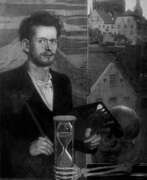

Oskar Bruno Zwintscher was a German painter. He is often associated with the Jugendstil movement. From 1887 to 1890 he studied at the Hochschule für Grafik und Buchkunst Leipzig and, from 1890 to 1892 was a student at the Dresden Academy of Fine Arts. After his studies, he became a free-lance painter in Meißen, where he received a stipendium, awarded to Saxon painters by the "Munkeltsche Legat". In 1898, he presented his first large collection of paintings to the public. That same year, he was a prizewinner at a contest held by the entrepreneur Ludwig Stollwerck to select artists for a new line of trading cards. His first series of cards, "Jahreszeiten" (The Seasons), was published later that year. This was followed in 1900 by "Das Gewitter" (The Tempest). From 1903, he served as a professor at the Dresden Academy. He was an unshakable opponent of impressionism. Despite this, and his involvement with advertising, much of his work is openly erotic or has an eerie quality. His style has been likened to a contemporary version of Holbein or Cranach, but also contains elements of Art Nouveau.




